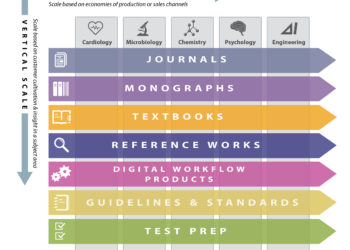Society sustainability was a topic for discussion long before the release of Plan S. We discussed the future of membership more than three years ago here in The Scholarly Kitchen. I’m sure many of us have also attended several conference sessions at various industry events that have discussed the trends that will likely impact the role of societies as related to research, publications, professional meetings, education, communities, and more. There is no denying that societies are facing pressure from many angles.
Additionally, although the need for evolution is evident, society structures can make change difficult. Again, there have been several posts in The Scholarly Kitchen related to the trials and tribulations of not-for-profit governance as well as how to build and manage effective boards.
But with the publication of Plan S and the debates around its potential unintended consequences, the sustainability of publishing revenue, the financial cornerstone of many societies, could experience increased pressure. So this month we asked the asked the Chefs:
How can societies be sustainable with all of the current pressures on their established revenue sources?

Angela Cochran: When the American Society of Civil Engineers (ASCE) was formed in the 1850s, it was a group of civil engineers in the greater New York area that thought it was a good idea to share what they were doing to learn from one another. Their mission was, in part, to advance their own knowledge, but mostly about advancing the profession and improving public health and safety. Many members of our organization continue to be engaged in the mission of advancing the profession. They review journal articles, serve on standards committees, participate in legislative activities, etc.
What we have been seeing is a shift from, “how can I make the profession better” to “how can you, the society, make me better.” How can you help me get the credentials I need? How can you keep me informed of new technology? How can you help me get the promotion or the new job opportunity. (Note: this is not a knock on millennials. These attitudes have been changing since the baby boomer generation came of age.)
In the end, the mission is the same — if we make civil engineers better, we make the profession better. This is literally the new purpose statement of ASCE. Even if the mission is the same, the way to meet that mission has changed significantly. Membership societies used to be the social network. People join societies now in hopes that it will advance their careers, not just out of a duty to support the profession.
People join societies now in hopes that it will advance their careers, not just out of a duty to support the profession.
It can be very difficult for an organization to split into two different services — one for established members and one for younger members, but that is what is needed. To add to the complexity, the leadership of many organizations will likely be long-time members that are well established in their field. What they want from an organization is different than what younger members (or potential members) may want.
Successful societies will be able to identify the needs of the new generations and pivot to those — mentoring, targeted career networking, certifications — while still providing value to the long-time members.
The question being asked here is how to remain sustainable in this new reality — the reality of lower conference attendance, lower membership rates, and fierce competition being offered for continuing education and technical information, some of which may be free from other entities. Here are a few thoughts:
- Look for ways to repurpose existing content so that it is personalized for members. This could be new subscription packages on content specific to the needs of smaller groups of members.
- Use the data that you have to put what members want in front of them. Stop being passive and assume that if you throw everything and the kitchen sink at members, they will somehow pick out the few things they find valuable. This is lazy in the day and age of big data. You know what they want because you know which webinars they attended, which conferences they traveled to, which publications they engage with, which committees they sit on.
- Resist the urge to make all valuable offerings free to members. If you have new products or services that are of value to the membership, they will pay for those. Once you give it away with membership, it has less value and provides no revenue.
- Weave younger members into all areas of your organization — on your committees, on your boards, on your content creation teams. Once they are there, make sure they have a voice (you know the word…inclusion). Every society has some highly regarded well-established members that monopolize every committee they happen to sit on. Insist on committees being inclusive of ALL new voices and ideas.
Stop being passive and assume that if you throw everything and the kitchen sink at members, they will somehow pick out the few things they find valuable.
Strong societies aren’t focusing on what their members want, but instead are focusing on what potential members want. It’s a balancing act, but one that any organization with strong leadership can attain.
Lisa Janicke Hinchliffe: Association sustainability flows from member — and potential member — needs and building a business model that supports the services to meet those needs. When I was President of the Association of College and Research Libraries (ACRL), which is an interesting hybrid of a professional association and a scholarly society, I had the benefit of attending the American Society of Association Executives‘ intensive training institute for chief elected and chief executive officers.
ACRL already had a strong tradition of ongoing assessment of member needs and values and, through that training, I learned strategies for shaping the association to respond to those needs and values. While in a former era, associations were the primary way of building one’s network and entering a disciplinary community of practice, that is no longer the case. Digital platforms make it possible to develop one’s own connections and find those with common interests. For the association then, it can no longer rely on providing a scarce resource (i.e., connections to others in the field) and must position itself with a unique offering among the many that are available. In my view, this means becoming more values-driven, to make membership desirable and part of identity.
For the association then, it can no longer rely on providing a scarce resource (i.e., connections to others in the field) and must position itself with a unique offering among the many that are available.
As two examples of meeting needs and reflecting values: During my presidency (2010-2011), ACRL kicked off the “Value of Academic Libraries” initiative, responding to the identification of this as the top challenge being faced in the field. Instead of putting those resources behind the membership paywall, we made them openly available to all. In addition, ACRL flipped College and Research Libraries to a diamond open-access journal, funded by the association. With respect to both of these, non-members reported they were joining because they wanted to be part of these exciting directions. Joining, not because they had to but because they wanted to. I don’t know what the specific value and values proposition should be for any other association; however, I do believe those must be the foundation and then a business model developed from there.
Joe Esposito: There is no single answer to this question. Every society is different; even societies that are roughly the same size and have a similar number of publications have different strategic issues. Societies vary by size, financial reserves, field of study, the nature of the governance structure, the character of the active membership in leadership, the professional staffing, and so on. This list could go on for pages. In order to come up with a plan for sustainability, it’s necessary to drill into the workings of the society itself and also into how the particular field is evolving. I am concerned that we are going to see cookie-cutter solutions proposed everywhere, typically by people who don’t understand the complexity of societies’ missions and operations.
In order to come up with a plan for sustainability, it’s necessary to drill into the workings of the society itself and also into how the particular field is evolving.
Alice Meadows: It’s been a while since I’ve been closely involved in society publishing, which typically represents a large chunk of revenue for scholarly societies, along with conferences and membership dues. So I don’t know how many societies are actually experiencing a significant decrease in any of these revenue streams, though I do of course know that there are concerns that Plan S could have a major impact on their publishing income.
However, from my experience as both a member and a Board member of the Society for Scholarly Publishing (SSP), as well as from my previous experience as Director of Society Relations at Wiley, I know that what successful societies — of all sizes — do really well is to understand their community’s needs, and to develop services to meet those needs. And I believe that the researchers in those communities truly value this and will continue to support their societies, as long as they continue to meet their needs. Historically this has included sharing their research in society publications or at society conferences. I don’t think this will change any time soon.
But, as their communities’ preferences about how to do this change, societies will have to adapt to meet those changing needs. This will vary by discipline, as it always has, with (for example) some societies already embracing open access — because that’s what their members want and need — while others are not yet doing so because their community has not expressed that need. I am confident that societies will continue to be sustainable as long as they continue to listen to — and respond to — the needs of their communities.
David Smith:
First the assumptions:
- Those external pressures take effect over a short to medium timeframe (<5years).
- That membership dues do not cover the full gamut of activities that the society has been directed to undertake via its mission and governance.
- That an established society has evolved to very effectively exist within the environment in which it operates.
- That given point 3 above, the available surplus generating assets are being exploited sufficiently to enable the currently defined mission
Option 1) If there are reserves – the society can ‘figure things out’ while relying on the cash in the bank. But that doesn’t solve the problem.
Option 2) The society can radically refactor its mission in order to meet the new reality. This will be very consequential; a diminution of mission goals; a possible/likely hit to membership income and support; significant cessation of programs and activities. This could lead to the organization ultimately ceasing to exist. At scale – this is an existential risk to the concept of the learned organization.
Option 3) Merge with one or more other aligned societies. This is a logical outcome of options 1 and 2
Option 4) Form a cooperative movement. The original cooperatives were formed in the UK in response to the disruption wrought by the industrial revolution. The first cooperatives mostly failed within a generation, but from the 1840s on, some stable cooperatives formed and have continued to exist up until the present day. They are not restricted solely to the UK. But these are economic cooperatives. It’s not clear that mission cooperatives can exist, given that mission is a differentiation for societies. And there are a number of societies and institutions who compete with each other economically – especially an issue in cross cutting or broad fields.
Option 5) Develop (genuinely) new revenue streams to reduce or eliminate the impact of the loss of existing revenue. Notice I said streams. This is a new markets and new customer problem (assumption: existing markets and customers are not going to deliver the lost revenue). The challenges here are multitudinous. Most new ventures fail. So to do this, a society will need to develop potential new market offerings AND be able to survive long enough to enable it to work out which will be successful, and the extent to which these will cover any revenue gap (see option 2).
And here is the central challenge. How are societies to be supported to develop these new offerings? They exist within a complex ecosystem. It’s NOT the library budget that pays for societies – they both exist in a symbiotic relationship with the Institutions and Universities and seats of learning that support their members. They exist further within National and International environments of government/pan governmental funding for scholarship. In the UK, the ROI for STEM investment is estimated at around 7:1 and societies are a link in that incredibly successful payback on investment. The desire to change the current way of doing things is laudable, but it is vital that ALL links in the ecosystem are supported in their efforts to transition to a new scholarly environment.
The desire to change the current way of doing things is laudable, but it is vital that ALL links in the ecosystem are supported in their efforts to transition to a new scholarly environment.
Tim Vines: First, societies should take a hard, cynical look at their journals – these exist to communicate the society’s values and expertise to the world, but what does the peer review and publication experience say about the society? Are the author guidelines clogged with irrelevant, outdated, and contradictory requirements? Are society members bombarded with one or more review requests per day? Is the decision making process consistent? Developing sustainable revenues from a journal is much easier when it has the enthusiastic support of its community. Second, societies could rebuild membership as a source of revenue. For example, one could establish consortia with related societies and offer joint individual memberships to researchers. Joint memberships would offer significant economies of scale for attracting new members and retaining existing ones.
Robert Harington: It’s all about balance. True, there are significant pressures on society revenues, especially publishing revenues. My message is that we should not panic. The pressures that are unfolding are by no means defined. One can sense the prevailing wind of openness, but how that will play out seems yet to be determined. We have done our best, not least here in The Scholarly Kitchen, to define what the risks and benefits are if Europe proceeds with Plan S. But Plan S is not policy – at least not yet. In the USA, while openness is certainly on the minds of OSTP, it does not seem likely that we will go the same path as Europe. In other countries such as India, it seems clear that there is a willingness to embrace open access policies such as Plan S, but there is little money to fund it.
Then, of course there are the Read and Publish/Publish and Read deals popping up on the horizon. And then again, interesting ventures such as Subscribe to Open from Annual Reviews. Societies are in the same boat. We want to embrace openness as our communities see need.
In mathematics, we have had such balance for decades. Almost every math journal article appears in arXiv before publication, and as such openness of research is an indelible part of the ecosystem. In fact it may be interesting for readers to look at another interesting open access plan based around preprint servers, from the founders of bioRxiv, called Plan U. For the American Mathematical Society (AMS), around a quarter of our journal authors receive funding from a funder. We have to balance the needs of researchers of many varieties, yet do so in a climate of increased openness.
All this to say, that from where I sit at the AMS, we envision a varied and balanced portfolio of publications – books, journals and our discovery database, MathSciNet®, with business models suited to the full range of mathematicians we serve around the world.
The pressures that are unfolding are by no means defined. One can sense the prevailing wind of openness, but how that will play out seems yet to be determined.
Karin Wulf: The diversity that characterizes the world of scholarship extends to organizations, which in the humanities may be very large by discipline (the American Historical Association) or field (the Renaissance Society of America), or much more modest, also by discipline or field. The activities in which humanities societies engage might look similar. These are often a different combination of professional meetings, including smaller gatherings such as seminars and workshops, and larger conferences, support for scholars in the form of fellowships and prizes, and publications. The revenues generated for and from society activities are also highly variable. Speaking only for my own organization, we have a high net negative for our publications, a modest net negative for our events, and a lightly net negative for scholar support. What makes this possible is sponsor support, an endowment (modest by most standards), individual gifts, grants, and membership (in that order).
We work incredibly hard to make the value of our work clear and compelling to our constituency…While much of our work may be free to consume, it is not free to produce.
The kinds of pressures that we experience are those common to many societies, however, whether humanities or STEM, publications revenue-dependent or not. And the answer for us is, I suspect, similar to the answer for many: value. We work incredibly hard to make the value of our work clear and compelling to our constituency. Without making that case, we are not sustainable. While much of our work may be free to consume, it is not free to produce. It takes skill, talent, and time to edit publications, market meetings, and compete for grants. It takes a full complement of staff and governing committees. But the net positive for scholars, scholarship, and an engaged public is a worthwhile investment of resources.
Ann Michael: While it’s clear that all societies are different and specific plans will vary not only by discipline but at the society level itself, it’s valuable to consider the broader avenues that might be open to societies. From there, as Joe Esposito says, each society has to deeply consider its own community, mission, financial position, leadership, etc. I do personally find it interesting that we haven’t seen more society mergers and acquisitions (David Smith’s Option 3). As other Chefs have mentioned, pursuing scale is one potential strategic component for sustainability.
Now it’s your turn!
How do you think societies can be sustainable with all of the current pressures on their established revenue sources?
Discussion
3 Thoughts on "Ask The Chefs: Society Sustainability"
Dear Society Publisher,
The Wellcome Trust, UKRI, and the Association of Learned, Professional & Scholarly Publishers (ALPSP) have commissioned a study to explore a range of potential strategies and business models to support learned society publishers successfully transition to open access (OA) and align with Plan S.
We are keen to hear from a broad spectrum of society publishers, and hope you would be willing to spend some time reflecting on a discussion paper [http://www.informationpower.co.uk/consultation/] and then completing a short survey [https://www.surveymonkey.co.uk/r/ZPB299D]. The paper will be further developed and improved with feedback from this survey and continued engagement with learned society publishers and other stakeholders as the project progresses.
• The survey will take around ten to fifteen minutes to complete.
• The first five questions are about the journals you publish. This will enable us to review your responses in context.
• The next 7 questions are about the 7 categories of approaches and models presented in the discussion paper.
• Finally, we ask about ideas you may have and are willing to share.
Your expert feedback and insights will inform further discussion and enable us to refine the possible models. We thank you for your time,
Lorraine Estelle & Alicia Wise
Information Power Limited
http://www.informationpower.co.uk/
This is a really helpful article for people like me who wants to know what scientific editors think about this big question. Thanks, Ann!
I personally think developing a CME program could be a way to sustain revenue and readership, especially for medical journals. Since this provides a new marketing opportunity for journals, and I believe a lot of readers who are in the clinical field have the needs to gain credits, and journals can surely provide it if they have CME program in place.
I’d love to hear your opinion.
Ann – just caught up on this and it’s great to get this diverse group of thinkers and contributors on this topic. The concern and tension in the current environment are palpable. Perhaps especially for those with a higher dependency on publishing revenues, and especially those for who geography, perceived research quality and/or discipline contribute to a lower likelihood of an author-paid future. And we operate always under the ongoing constraint of publishing volume and inflation outstripping library budget growth.
That said, there are reasons for hope. I’m fortunate, as you are, to meet many societies across the spectrum and
– the core mission resonates: advancing research and practice and engaging community are goals that I (and we at Elsevier) fervently believe will sustain societies
– we are seeing greater engagement with OA – flips, mirrors, (daughters, sisters…) and yes, still hybrid: the right choice is out there for many and in many cases is straightforward
– we see growing value creation (and capture) beyond the traditional conference, programme, membership dynamic. This would include new platform and product collaborations, cross-society collaboration, software and service partnerships, the beginnings of monetising data, CPD/CME, guidelines, showcasing member research, helping the community stay up to date, ethical and policy advocacy and more…
– we see increasing co-operation in using technology to reduce cost and environmental footprint (using machine learning and AI to enhance copyediting and typesetting workflow, retiring small circulation print etc)
More generally, whilst we plan for many scenarios, I suspect that
1. in a world where c. 85% of scholarly output globally is subscription and continues to grow in volume, societies will be able to continue being strong supporters of Author Choice and support the variety of publishing needs of all researchers around the world. In short, hybrid is nowhere near dead and other options exist 🙂
2. as publish and read deals mature in their construction, value distribution will get increasingly fairly addressed: it will be complicated as we already see in Germany, but it will be distributed and it will reduce the existentialist intensity of the current threat
None of the above escapes in full the volatility in the current environment. General and print to digital challenges in the commercial markets continue and there will be a subset of the community that will ONLY survive in current form if successful in challenging a one-size-fits all author-paid model: this speaks to the importance of all societies being vocal and present in the current debates. However, overall we have a very positive sentiment about societies future, especially where we see openness to innovation and a continued focus on creating value for research, practice and community.



